Cherrye S. Vasquez's Blog, page 7
July 12, 2013
Do you know someone with a Chronic Illness & all they may need is a little “pat and push?”
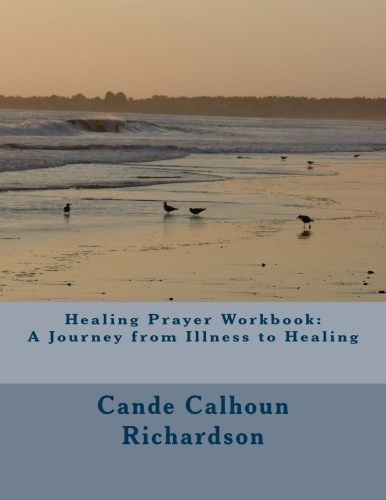 Do you know someone with a chronic illness and all they may need is a little “pat and push?”
Do you know someone with a chronic illness and all they may need is a little “pat and push?”
Journal writing is one way to obtain peace. “Healing Prayer Workbook: A Journey from Illness to Healing” is an excellent workbook to use as one maintains their strength, faith and connection to the Lord.
Author, Cande Richardson, has a chronic illness, but she is a fighter and “go getter.” She has chosen not to let her illness be a setback or intrusion in her life. She believes that you can have the same goals for your life. According to Richardson, there is hope for healing.
Richardson’s workbook is full of empowering scriptures, and is an excellent tool for journal writing, logging important dates, family contacts, daily feelings and interactions, contacts and final wishes.
“Healing Prayer Workbook: A Journey from Illness to Healing”
Do you now someone with a Chronic Illness & all they may need is a little “pat and push?”
 Do you know someone with a chronic illness and all they may need is a little “pat and push?”
Do you know someone with a chronic illness and all they may need is a little “pat and push?”
Journal writing is one way to obtain peace. “Healing Prayer Workbook: A Journey from Illness to Healing” is an excellent workbook to use as one maintains their strength, faith and connection to the Lord.
Author, Cande Richardson, has a chronic illness, but she is a fighter and “go getter.” She has chosen not to let her illness be a setback or intrusion in her life. She believes that you can have the same goals for your life. According to Richardson, there is hope for healing.
Richardson’s workbook is full of empowering scriptures, and is an excellent tool for journal writing, logging important dates, family contacts, daily feelings and interactions, contacts and final wishes.
“Healing Prayer Workbook: A Journey from Illness to Healing”
July 7, 2013
Effective Communication is an Art
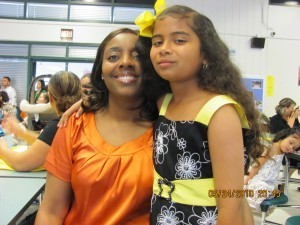 As a 32 year public educator and adjunct professor the last 6 years, I often ask my students to write reflection papers. Although I give them thorough instructions, almost immediately one will ask: “What point of view do you want us to take?” I’ll answer by saying, “Take your point of view. I want to hear your stance, thoughts, and opinions on topics. You may respond using creative thoughts, artifacts, and etc. You may make your response as interesting and lively as deemed appropriate.”
As a 32 year public educator and adjunct professor the last 6 years, I often ask my students to write reflection papers. Although I give them thorough instructions, almost immediately one will ask: “What point of view do you want us to take?” I’ll answer by saying, “Take your point of view. I want to hear your stance, thoughts, and opinions on topics. You may respond using creative thoughts, artifacts, and etc. You may make your response as interesting and lively as deemed appropriate.”
I do this because I want my students, who by the way are aspiring to become Instructional Leaders in our classrooms of tomorrow, to realize that communication may have many different, but interesting facets. Too, communication is two-way. One has to listen attentively to others first, then share their thoughts on the matter at hand. Sharing and listening garners respect. Leaders must be able to role model appropriate ways to converse. If we can do this as adults, surely our children will follow.
Just long as my adult students use friendly discourse as they dialogue one to another, and respect one another’s sharing, the “sky is the limit.” One other point I stress to my students is this: You never have to subject yourselves to, or agree with another’s thoughts and opinions, but it is always kosher to agree to disagree in friendly, professional ways.
When I teach courses online, we term using politeness and good manners “netiquette.” Netiquette is merely online etiquette. Students must converse one to another exercising respect and consideration while in forum discussions. Rudeness, put downs and harshness are not communicative options. In fact, these are forms of bullying behaviors that should never be tolerated within an online community, network or forum discussions.
My students are taught this: If you can utilize another person’s point of view/information in your world, run with it. If the information doesn’t fit your expectations and/or character, leave it. Perhaps someone can/will benefit from the information. Just because YOU think it’s not worthy, doesn’t mean that someone else feels the same way.
Responding negatively using “put downs” criticism is a no-no. Effective communication is an art, and it takes maturity.
As a professor I feel that I owe this training to my students. I instill such tactics within them because they’ll be a part of many different administrative teams as they share their expertise and knowledge.
I also take this idea seriously as I join and become a part of forum discussions. I love sharing and learning from others. As educators, adults, parents, authors, and community leaders we must role model effective communication. We’d surely want our children to communicate well in classrooms and abroad.
Remember, it’s okay to disagree with another’s point of view, but try to understand them before “tuning them out.” Give what they have to say a “fighting chance.”
Suggestions of how to use phrases as a Segway to better understand another’s Thoughts/Points of Views:
Probe further by stating/asking:
“You said ….. Would you explain what you were referring to?” (Be sure to use direct quotes. Never make false accusations, put words in someone’s mouth, or summarize what you think they said in your own words).
Here is my take on your opinion….
Once upon a time I….
From my experience on the subject……
I read an article once that suggested….
Did you know that recent statistics reveal …..?
Sounds interesting. Here’s my stance on the topic…..
I don’t exactly agree with your thought on this subject, but can we agree to disagree? Here’s why….
Have you ever thought about it this way?
Finally, effective communication takes skill. If you are ever a part of group/forum discussions and your opinions/thoughts aren’t being acknowledged, or if the group’s moderator is insensitive, lack the skills, professionalism and maturity needed to facilitate appropriately, kindly bow out and attach yourself to groups that are uplifting, empowering, and those making stark differences in the lives of others. There are several such groups out there and your voice counts. Who knows, what you have to offer could make a positive difference in someone’s life.
Featured Photo – Author, Cande C. Richardson – “Healing Prayer Workbook: A Journey from Illness to Healing” & Illustrator, Kelly A. Vasquez “Guess What? Dear Diary”
Photo Courtesy of: Dr. Cherrye S. Vasquez
June 9, 2013
My Skin
 Our children focus primarily on Reading and Math skills in schools, but Writing has become a focal point in today’s schools so much so some districts are hiring consultants to help teachers expound upon the essential elements of good and skillful writing.
Our children focus primarily on Reading and Math skills in schools, but Writing has become a focal point in today’s schools so much so some districts are hiring consultants to help teachers expound upon the essential elements of good and skillful writing.
As I cleaned out my daughter’s binder at the close of this school year, I happened upon this piece of writing that intrigued me enough to share it with my readers.
My Skin
My skin reminds me of a tan, but it’s my natural look
It reminds me of a clipboard and caramel
It reminds me of my dad drinking coffee
It feels like a very smooth and hairy part of me, and I love it
I love my skin color because it’s mine
It even reminds me of freshly new born puppy’s fur, so soft and silky
A baby pine tree, but on the inside
Written by: Kelly A. Vasquez
I love how my daughter expressed herself using similes/metaphors. I am not surprised, but am happy that she loves her skin tone. One of my platform topics center on diversity issues as I embrace children loving who they are both inside and out.
May 31, 2013
My Child is being Bullied: Now What?
 Bullying is a pandemic in our nation’s schools. Realizing this, we must do all that we can to help our children deal with the pressures that these annoying behaviors poses on their lives. Parents, we have a huge responsibility, but are we doing all that we can to intervene?
Bullying is a pandemic in our nation’s schools. Realizing this, we must do all that we can to help our children deal with the pressures that these annoying behaviors poses on their lives. Parents, we have a huge responsibility, but are we doing all that we can to intervene?
Let me ask these questions
As a parent, are you aware of the anti-bullying laws and policies in place at your child’s school? If so, how is it being enforced? If not, have you voiced your concerns and/or asked to work closely with school officials in hope to create anti-bullying procedures at your child’s school? Do you know if school officials at your child’s school are clear about what actually constitutes bullying behaviors?
In some cases, there are concerns about what constitutes bullying behaviors verses normal play, or friendly horsing around. I know that you have these concerns too, so I’ll define what bullying is and what it looks like.
Bullying Defined
Verbal (name calling, teasing, insulting, or threatening)
Physical (hitting, kicking, scratching, pushing, stealing, hiding/destroying someone else’s property)
Social (refusing to talk to or play with someone, purposefully excluding someone)
Cyber (using electronics such as computer to write mean, demeaning messages about someone)
There are signs of bullying that you can watch for
Poor eating habits or asking to eat as soon as he/she gets home – bully takes lunch or lunch money
Depression
Torn clothes or mysterious bruises/scratches
Isolating self from others – appearing lonely
A change in grades – poor grades
A sudden dislike for school
Exhibiting unfounded anxiety
Low self-esteem
Complaint of sick feelings – stomach aches, headaches
Asking not to go to school
Signs of threats or suicide
If you have reason to believe that your child is being bullied
Stop, Look & Listen NOW
Talk to your child. Ask him/her about their school day. Ask if there is anything that you should know. Whatever you are doing or plan to do, stop! Your child must trust that you will drop whatever you are doing to see him/her through this crisis. Your child needs to know that you are listening to them; you hear their frustration and the pain that they are experiencing. You may want to repeat what you heard them say to you, thereby acknowledging that you are really listening. Let your child know that you will be there for them “at all costs.”
Documentation
Get the story as clearly as possible from your child and document everything from your child’s version of the bullying incidents to every conversation you have with school officials. Be sure to write things down as soon as an occurrence arises or a conversation happens. This way, incidents are still fresh in your child’s mind. You may want to keep documentation separated by tabs in a tablet or a notebook to maintain a distinct record of each person’s story. It will be important to keep your child’s version separate from a school official’s so that messages don’t end up overlapping, getting accidentally mixed-up or combined.
Have other students been affected by the bully or bullies who are attacking your child? If so, what are their names? Were there any witnesses to the incidents? If so, what are their names? Does your child remember which class the other students are enrolled in? Can your child point them out? Encourage school officials to interview other children who may have been bullied.
Use dates, times and settings in your documentation. Did the incident happen in the cafeteria, classroom, or playground? Detailed documentation will not only help school officials target bullying incidents, but it will also give school officials an indication of how best to resolve issues as they examine antecedents (causes/variables that may have prompted the bully to react inappropriately), so that changes and individually tailored support plans can be implemented.
Approach school staff immediately
Bullying will not just stop on its own. Don’t be afraid to approach school administrators.
You might find that some school officials and administrators may be territorial and believe that they are the educational experts, and you are “just a parent.” Since you are your child’s greatest advocate, here are a few ideas about how to approach the issue of your child being bullied while working collaboratively with school officials:
Do your research. You can assist school leaders with ideas of how to bully shield and bully proof the school that your child attends.
Approach the school leaders as if you are on their side. Do what you can to avoid creating an adversarial relationship between you and the people who have the power to help stop what is happening
Let the school leaders know that you are not only concerned about your child, but all children enrolled at the school. This will soften your approach thereby giving you greater lead-in for support and next steps.
Begin speaking to the school counselor before working your way up the organizational chart – Test the water, first.
When my own child was bullied at school, I spoke to the school principal directly. Due to budget cuts, this particular school had no assigned counselor. I approached the situation as a concern for the other child as well as my very own child. I said, “Perhaps this young girl is having personal problems in her home- life that’s making her feel angry.” Other times I would say, “Sounds like this child wants to take charge and is a bit bossy. Perhaps she can be shown how to use her leadership skills in a more positive and productive manner.” By using this approach with the school principal, I believe that I softened the conversation, thereby gaining the principal’s attention. It appeared that she was more willing to hear me.
But, there are times when the school will not help, so now what can you do?
Before I address this problem, I want to urge parents to always gather as much information about your school the first week or two of the new school year. This is the time when the climate is still warm and friendly, and stress levels aren’t heightened due to the pressures of trying to keep up with everyday school life. Know the district level office organizational chart and levels of administration assigned to your child’s campus. Attempt to retrieve their contact information such as names, email addresses, voice mail, and telephone numbers, and perhaps location of their office – this is last resort and never show up without an appointment.
When your child’s school will not listen to you or help you through a bullying crisis, and you know that you have done your part, you have spoken to the classroom teacher, school counselor, assistant principal and principal if circumstances have taken you this far, you should contact central office staff and speak to your child’s school assigned area superintendent.
Share your concerns and let this individual know that you have tried to work collaboratively with school officials at the campus level of your child’s school. Trust me – Now that bullying has gained national attention, there is no doubt that this person will be all ears.
There are approximately 48 states that have laws mandating anti-bullying programs and services in schools, but some schools have been slow in implementing the programs.
Be sure that you know the anti-bullying laws of your state (Bully Police, USAhas a state by state listing of anti-bullying legislation). Be ready and able to recite the Senate Bill and House Bill laws associated with the bully’s offense. For example, if you live in Texasand your child is experiencing sexual harassment issues at school, and no one will address the issue, share your knowledge of SB 471 and HB 194. If you do this, everyone will know that you mean business!
When to call a lawyer
If you have gone through all the recommended steps above, more than likely you will not have to call a lawyer; however there may be times when your story will land on “deaf ears.” If no one will listen to you, or if everyone has listened to you and they have chosen not to intervene, there is no more time to waste. You will want to get legal advice immediately. Time is of the essence and the safety of your child is paramount!
Focus on your child
Remember, there are effective steps that you can take as your child’s anti-bullying advocate. Consider the fact that bullying related suicides are real.
STOP whatever you’re doing and act quickly on your child’s behalf. Our children count on us to help them during crisis. This is not the time to put ANYTHING else before your child. Show your child that they can trust and count on you.
About the author
Author Cherrye Vasquez has a Ph.D. in Curriculum & Instruction; a Ms.Ed in Special Education; and a BA in Speech Pathology/Audiology. She specializes in Multi-cultural education and holds certifications in Early Childhood Handicapped, Mid-Management and Educational Diagnostician.
Cherrye is passionate about empowering children, so her platform centers on diversity and bullying issues. She feels strongly that if children are empowered and armed with the tools needed for a deep love of self and self-identity, they will be able to withstand life’s challenges, including bullies.
Website:
https://twitter.com/bullieswillstop
http://www.facebook.com/BooksThatSow
Opt-in Page – Sign up to receive helpful tips and news you can use to help stop bullying
http://cherryevasquez.tateauthor.com/help-stop-bullying/
Summer 2013 – Please look for Cherrye’s new release – Clique, Clique, Stop
Summer 2014 – Cherrye’s Bully book will be released.
May 30, 2013
How to Stop Bullying: Deal with Bullying Behaviors when Children are Still Young
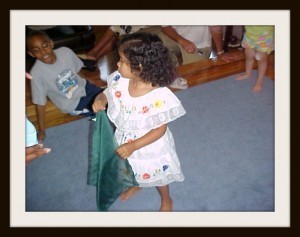 I am a firm believer that parents, educators and classroom teachers already know how to stop bullying behaviors. These important “players” in the lives of children just need reminders that they are the adults who are in the “driver’s seat” and can shape children’s ideals and behaviors while they are still young, moldable and impressionable. Yes, we can deal with bullying behaviors when children are still young.
I am a firm believer that parents, educators and classroom teachers already know how to stop bullying behaviors. These important “players” in the lives of children just need reminders that they are the adults who are in the “driver’s seat” and can shape children’s ideals and behaviors while they are still young, moldable and impressionable. Yes, we can deal with bullying behaviors when children are still young.
We can teach children the “golden rule” and we all know what that rule entails: Treat others the exact way that you’d want to be treated. If this is true, who would bring harm to themselves?
It is within the duration of the younger years that we have the control for shaping the minds and hearts of children. Throughout this very crucial time in their lives we will want to instill deep-seeded attitudes of care, appreciation and remorse for the feelings of others, especially their family members, siblings and play mates. For the period of their formative years parents can observe how their children interact with their dolls, pets, and friends on play dates.
Parents, educators and classroom teachers will want to redirect inappropriate and unfavorable actions made by children and talk with them about feelings and how their behaviors may impinge on their friends who could become upset by their harmful words or inappropriate physical and perhaps harmful touch. Every one mentioned above should take time and use these upsets as “teachable moments.”
Stop inappropriate behaviors on contact and redirect the child at that moment. While it isn’t necessary to place the child in an uncomfortable embarrassing moment, adults should promptly remove the child and have a word with them in private.
How to Stop Bullying Behaviors while Children are still Young:
1. Using a calm voice, get the child’s attention
2. Tell the child that you’d like to have a word with him/her
3. Walk over to a quiet place
4. Get down on the child’s eye level and make sure there is eye contact
5. Tell the child what you observed
6. Give the child time to respond
7. Ask the child how they might feel if their friend reciprocated the same actions/words toward them
8. Talk about feelings and care for friends
9. Talk about maintaining friends and returning for future play dates
I believe strongly in the Proverb: “Train up a child in the way he should go, and when he is old, he will not depart from it.” Feelings of remorse and care grow over time. If you’ve never had it, it will be hard to harvest it as a child grows older into the age of accountability.
March 24, 2013
Her Money, My Money – Teaching Money Management/Sense
 It comes a time when we have to teach our children how to make informed decisions about money and money management. This way, they can make financial decisions that’ll prove to make them healthy financial managers for their future. At least this is my hope.
It comes a time when we have to teach our children how to make informed decisions about money and money management. This way, they can make financial decisions that’ll prove to make them healthy financial managers for their future. At least this is my hope.
For a few years now I’ve given my child $20.00 a month for her allowance. You know, just money to have in her pocket to spend on items when we are out and about, and so that she can learn money exchange and money sense.
She earns this money for doing small household chores, but our agreement is that when she reaches $100.00 she takes it to the bank and deposits into her savings account. Whatever is left, she can spend on a few things, but also put a few bucks in church.
Well, she’d saved $152.00 here lately, but I suppose she was “itching to spend it.” She’d talked earlier about reaching her goal of $100.00 and having an access of $52.00 to spend, but she thought about our trip to Barnes and Noble Booksellers.
Since we’d be at Barnes and Noble Booksellers for a book signing anyway, and she’d wanted to go there since Spring Break, she thought about three books she wanted. Of course spending money on books is certainly a great way to spend her money. She had my blessing for sure! What she hadn’t planned on this time is that although I agreed to her new purchases, I’d be informing her that she would have to bring her own money along on this particular trip in order to buy her books.
I decided to do this because the last two purchases from Barnes and Noble Booksellers were “on me.” Not to mention that I purchased/funded her choice of books from Scholastic orders this entire school year. Needless to say, she has lots of books to read.
I wasn’t planning to see my daughter fall apart when I announced that while I had no problem with her purchases at Barnes and Noble, she’d have to go into her home “stash” and purchase her books with her own funds. When I told her this, you should have seen her reaction. She went on to tell me that a child should not have to pay for her own educational reading materials.
Educational? Well, although reading at any level using any material is great for children due to the fluency, comprehension, vocabulary building, and much more that they’d receive; I’d hardly think that “Big Nate” books are on the educational side. Now, don’t get me wrong, I am very happy to see my child reading, and I do not have a problem with “Big Nate” books, but the psyche, or reverse psychology she tried on me this time, just didn’t work.
Trying not to laugh and with a serious face, I convinced her that it would be wise to bring her own cash if she intended on buying new books. She asked, “How much money should I bring?” I said, well it depends on the cost of the books, so I don’t know, but I’d bring at least $30.00-40.00 if I were you.”
Later, I found out that she’d only brought $20.00 with her, but mind you her three books cost $39.09. Before we reached the clerk, I explained to her again that since her books cost more than she had in her pocket, I’d be more than happy to loan her the remainder. Trust me — I did not fail in my explanation to her that while I was helping her out I expected to receive every penny of it back when we returned back home, so I happily provided her a loan ($19.09).
Eyes rolled. These eyes were not mine.
The purchase was carried through, we left the store and ventured on into our day, had lunch at Olive Garden (on me – I will feed my child), and then ended up at the Mall. While at the Mall, my daughter decided she wanted a game for her Nintendo DS game (remember she didn’t have enough money to cover the amount for three books she wanted), but I consented to her purchase, but again explained clearly to her that I expected to get my money back. I didn’t stammer or stutter when I told her that I’d want the $37.88 back.
“Okay,” she said with a sigh. By now, I’m not fit to be called Mom!
Before leaving the Mall we stopped by Great American Cookies for cookies of course, and drinks (my treat).
We finally arrived home and I presented my daughter both receipts. She grudgingly went to her stash and counted out what she owed me and decided that I was a pitiful Mom who robbed her of her nice stash. Now she couldn’t make a $100.00 deposit and it was totally my fault.
After huffing and puffing — At one point she considered returning the game because she remembered the clerk saying that she could return it with a receipt within 30 days. I said, “Okay, that’s your decision. Just tape the receipt to the game so you won’t lose it, okay sweetie?” Eyes rolled again – again these were not my eyes. I suppose she really wanted the game because after a few minutes, she said, “Oh, I’ll keep it!”
There was a lesson learned, and I hope that my daughter learned more than I did, but I’ll admit that I learned a great deal too.
My child is okay with spending my money, but not hers. I believe that by handling these two situations this way, perhaps she’ll learn to make better decisions about how to spend her money. She’ll have to weigh her purchase decisions against her savings.
I watched my daughter sit for a while just staring at her money. She counted the remainder of her stash, and she wasn’t happy with her balance. Needless to say, she may decide to save more of her money and watch it grow in her savings account, especially since apparently she doesn’t feel so good about spending her money.
March 14, 2013
Assessments for Academic Growth Purposes – Not Punitive Measures, or Teaching to the Tests
 Just after Spring Break, our children will merge right into the testing season. STAAR testing will fill their lives for the next few days, and after that most will face Stanford 10. “Here a test, there a test, everywhere test – test.
Just after Spring Break, our children will merge right into the testing season. STAAR testing will fill their lives for the next few days, and after that most will face Stanford 10. “Here a test, there a test, everywhere test – test.
What is STAAR testing really doing for our children? Granted, I realize that there certainly needs to be an accountability system in place, but are we using assessments the way that they should be used to help move children forward?
I wouldn’t mind the assessments so much if they were designed to determine our children’s strength’s, and areas that need attention/improvement. But what are teachers doing with the information that they have gathered?
Are teachers using assessment results revealed from test scores to:
Reteach/reinforce learning?
Learn if students are in need of differing teaching strategies that match their learning modalities?
Find out if students learned what they were supposed to learn at a particular curricular Benchmark?
Reveal if students mastered what they’d hope they would?
Determine if students are prepared to undertake next set of academic goals?
Determine is students are ready for the next layer in their curriculum?
We have new tests sure enough, but are these new tests leading to new academic opportunities for our children?
Assessments should not be used for “I gotcha moments,” or for punitive measures.
How can we reform how test results are being used? I hate the seemingly “teaching to the test” method that’s being used today.
When we don’t use test results to ultimately benefit the students, we begin to lose them academically, behaviorally, socially and we cannot afford to do this in this 21st Century.
As a parent, I find myself purchasing lots of materials that I believe may help strengthen my child. My hope is to ensure that she not only knows the material, but she feels equipped and ready on test days. Perhaps I’m more nervous than she is, but I care for her preparation and emotional state.
What are your thoughts on this topic?
March 3, 2013
Your Child’s School Projects: Oh, The Headaches, but the Learning & Family Time Begins!
I know, I know, it takes lots of time and family effort to pull school projects together, but we did it! I am happy to report that my daughter, Kelly, earned 1st place in the 5th grade Science project last week, February 18, 2013.
The title of her project was “Can Spices Keep Cucumbers Fresh?” Kelly wanted to find out which ingredient mixed with water would render cucumbers edible after being put in Mason/Ball jars and then placed in a windowsill for six (6) days.
My daughter and husband went to the local Farmer’s Market in Houston and chose four (4) cucumbers approximately the same size and length.
I had the challenge of finding the right size Mason/Ball jars to use as containers and retrieving the tri-fold board.
 Kelly filled the Mason/Ball jars with 300 ml of water and put one cucumber in each jar. Each container would have its own separate ingredient. The ingredients that she chose to use are as follows: 3 tablespoons of (1) sugar, (2) salt, (3) real lemon juice extract and (4) non alcoholic white grape juice. Kelly closed the jars, my husband sealed them tightly and shook each for about 2 seconds, and then Kelly placed the four jars on a windowsill for six (6) days.
Kelly filled the Mason/Ball jars with 300 ml of water and put one cucumber in each jar. Each container would have its own separate ingredient. The ingredients that she chose to use are as follows: 3 tablespoons of (1) sugar, (2) salt, (3) real lemon juice extract and (4) non alcoholic white grape juice. Kelly closed the jars, my husband sealed them tightly and shook each for about 2 seconds, and then Kelly placed the four jars on a windowsill for six (6) days. 
Kelly was charged with writing daily observations of how each cucumber looked over the six day period. It wasn’t until day 4 that she began to see visible changes.
Of course, Kelly had to finalize her project by writing a research paper including her purpose, hypothesis, procedures, materials used, results (charts) and conclusions. She also included her daily logs, photos and an abstract. My husband created a board for her to showcase her Mason/Ball jars and glued each to the board for ease of carrying to school. She could not put her name on the project, or show any pictures of herself.
On the day of judging, Kelly was called to the school’s Multi-purpose room to explain her project to the judges. The judges seemingly were very impressed with Kelly’s ability to explain her scientific process. They were especially impressed with her bibliography and how well she followed their instructions as she put her project together.
I can tell you that the conclusion of the project revealed a null hypothesis. There is no way that the researcher would advise eating any of the four cucumbers, although the one in salt was the closest. Since salt is a preservative, it smelled like a pickle, but Kelly still would not advise eating it.
From this family project, came lots of togetherness, cooperation, headaches, toggling back in forth with each other’s ideas, but the best of all was the togetherness and the great learning experience that my daughter gained from this – not to mention the 1st Place certificate.
Although the pictures were taken a few days later, Kelly is seen standing near her tri-fold board holding her 1st place 5th grade Science Fair Certificate. 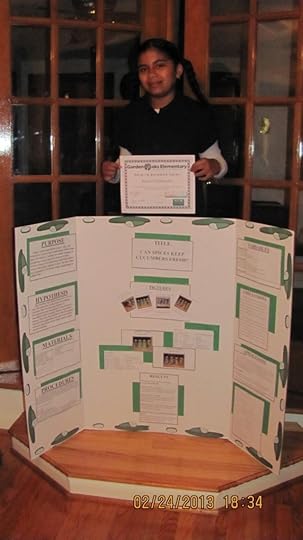
Now, we are on to our next family project. Kelly is entering the G.T. Expo Contest. The theme is: Living Museum of Scientific Inventors. This time Kelly has to decide on a famous environmental scientist and/or inventor to research and bring to life. I believe that she’s decided on Alexander Fleming. You know the guy who received credit for inventing penicillin. I can’t wait to share photos and the results of this project with you.
Kelly wants to present the facts about her inventor using another tri-fold board, but I’m trying to get her to do this in the form of a creative book with a bookmark (to give to visitors). Perhaps we can do all three!
Kelly will actually have to wear a costume that represents how her inventor would have dressed, and she will have to bring a coin receptacle of some sort for visitors to deposit small change which will bring (the inventor) to life. This one will prove to be such fun!
I promise to take lots of pictures and perhaps include a video next time, okay?
February 24, 2013
Keep Your Children Smiling and Ready to Go to School – The Nightmare of Bullying – Report it Anonymously
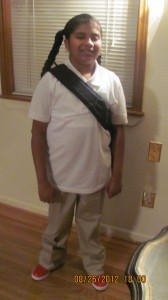 I love to see my daughter smiling and ready for school, and I aim to keep it this way. It hurts my heart to drop her at school realizing that she’ll face another day of torments from the hands of a bully.
I love to see my daughter smiling and ready for school, and I aim to keep it this way. It hurts my heart to drop her at school realizing that she’ll face another day of torments from the hands of a bully.
Many students and their parents fail to report bullying because they fear retaliation. Parents become emotional and of course want to protect their children, and most will do so “at the drop of a hat,” but children (at least mine does) will often say, “Hey wait, Mom. If you come to school and report any of this, it will only get worse. Let me try to handle it on my own.” Well, this all sounds good and of course we want our children to have the courage and problem solving skills to report incidences of bullying, but I strongly believe that when it has gotten to the point of mentioning it to a parent, it has to be the time for parental intervention. If not, perhaps the child is just asking for ideals in which to move forward in hopes for an end to the dilemma (nightmare).
Sounds sad, doesn’t it? At this point, who in the world would barge up to the school and lose all faith in the world of their child? As for myself, I’ve contemplated barging straight to the school while having the attitude that I’d dare someone to touch, or say any mean sarcastic word to her ever again once I “said my peace.” But, the truth is, and our children realize it first hand, if we did try to protect them from bullies — whether peer bullies or teacher bullies (sadly reporting), our children are exactly right – the “war is on.” This reporting issue may just backfire on them. More than I’d like to admit, peer bullies who are not directly handled and “called-out” with backing from their supportive parents (parents of the bully), or school officials, continue to bully in sneaky manipulative ways, and teacher bullies use the “power of the pen” and isolation to further torment children leaving them with guilty feelings of “Why in the world did I ever bother to tell my parents?”
With this in mind, there still has to be ways to intervene and “come to the rescue” of our children saving them from these tyrants. I’d like to stop here and offer a few tools that I hope will work for students and parents in these horrible situations.
Tools to Help Report Incidents of Bullying
Anonymously – create a form on line asking key questions so that school officials can arrange to be in certain areas on campuses to investigate
Privately – one-on one behind closed doors
Parental Intervention – some children may be so “fed up” that they are able to go to their parents and have their parents intervene without a problem
Buddy Reporting – perhaps a buddy won’t mind going to an adult for their friend who is being bullied
I’m sure that you have other tools that you can add to this list. If so, please feel free. Bullying has to end one way or another.
Video of Poems – The Bully-ee (victim) & The Bully (perpetrator)
Cherrye S. Vasquez's Blog
- Cherrye S. Vasquez's profile
- 37 followers



